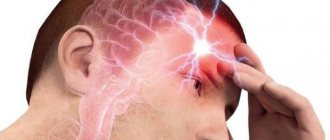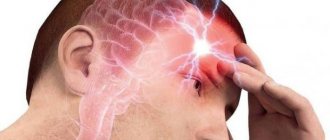Many therapists, cardiologists and endocrinologists call vegetative-vascular dystonia (synonym - neurocirculatory dystonia) the most common disease, which occurs in almost every second person. But in the International Classification of Diseases, the main document for doctors, there is no such diagnosis. You won’t find it in the records of doctors who work outside the CIS.
It turns out that there is no such disease. But many people experience very real symptoms of VSD. Where do they come from? And what to do if you have been diagnosed with VSD?
What is disrupted during vegetative-vascular dystonia?
First, let’s try to figure out what doctors most often mean when they say the phrase “vegetative-vascular dystonia.” Usually this term refers to a disruption of the nervous system, which regulates the functioning of all internal organs, glands, and blood vessels.
It is believed that disorders in VSD are functional in nature. In other words, the nerves are not working correctly, but they are not inflamed, not torn, and there is no infection, tumor or other pathological formations. Only the function is broken.
The section of the nervous system that regulates the functioning of organs, glands and blood vessels is called autonomic, or autonomic. In turn, it consists of two antagonist parts. Sympathetic nerves are activated in a state of stress and tone the body. Parasympathetics begin to work at rest.
Depending on which part “pulls the blanket over itself,” vegetative-vascular dystonia comes in two types:
- The sympathicotonic type is manifested by rapid heartbeat, high blood pressure, pale skin, anxiety, fear, deterioration of intestinal function, agitation, and chest pain.
- Vagotonic leads to a slower pulse, hypotension, difficulty breathing, increased sweating, redness of the skin, weakness, a feeling of lack of air, and more active bowel movements.
There are also mixed crises, when symptoms of different forms occur simultaneously or in turn.
Nutrition rules during VSD
It is believed that women are more likely to suffer from VSD. This is due to more frequent hormonal changes (pregnancy, childbirth, breastfeeding, menopause), peculiarities of endocrine function, and low stress resistance.
Nutrition for vegetative-vascular dystonia in women should be aimed at reducing hormonal disorders and psychological disorders (anxiety, hysteria).
There are certain nutritional rules that must be followed during VSD.
Rule 1
- It is advisable to gradually increase the amount of fluid consumed, because a lack of water in the body causes disruption of water-salt metabolism and the functioning of the immune, endocrine and enzyme systems.
Rule 2
- You need to eat in small portions and as often as possible. Overeating should not be allowed.
Rule 3
- Dishes should be quite varied.
Rule 4
- The daily menu should include vegetables, fruits, cereals, and soups.
Rule 5
- It is necessary to completely eliminate alcohol consumption.
Rule 6
- You need to limit your coffee consumption.
Rule 7
- You need to constantly listen to your body and its reaction to the food you eat. It is advisable to keep a food diary.
Symptoms of vegetative-vascular dystonia
Manifestations of VSD are diverse. They can be combined in different ways and are expressed to varying degrees:
- From the mental side: increased anxiety, frequent changes in emotions, difficulties in making decisions, poor sleep, various fears.
- Symptoms of general tone: constant weakness, increased fatigue, poor tolerance to psycho-emotional and physical stress, sensitivity to weather changes. These symptoms are combined under the general term “asthenia”.
- From the heart and blood vessels: decreased or increased blood pressure, increased or slowed pulse, pain in the heart (often occurs after a person gets nervous), sometimes mild heart rhythm disturbances. Patients often complain of dizziness and headaches, some periodically faint.
- Symptoms of VSD from the respiratory system: difficulty inhaling, feeling of lack of air. A person often feels that he needs to take a deep breath and go out into the fresh air.
- From the digestive system: nausea and vomiting, heartburn, bloating, constipation.
- From small vessels and metabolism: swelling, pallor and coldness of the fingers, hands and feet, muscle pain, chills.
Diagnostics
To begin with, the doctor, during a conversation with the patient, collects a detailed anamnesis - finds out the complaints, their nature, frequency of occurrence, the presence of a hereditary factor (are there people in the family who suffer from confirmed VSD).
Then a general examination is carried out, attention is paid to the patient’s behavior and his emotional background.
Due to the presence of symptoms similar to those of various other diseases (arrhythmia, hypertension, pathologies of the thyroid gland, gastritis, etc.), each patient with suspected VSD must undergo a detailed therapeutic examination in a clinical setting. To confirm the diagnosis of VSD, it is necessary to absolutely exclude diseases with similar symptoms. For this purpose, laboratory tests are prescribed:
- general blood analysis;
- general urine analysis;
- liver and kidney function indicators;
- analysis of thyroid hormone levels;
- clarifying tests at the discretion of the doctor.
Next, a referral is given for instrumental examinations, of which the most frequently used are:
- electrocardiography (ECG);
- echocardiography;
- 24-hour Holter blood pressure monitoring;
- fibrogastroduodenoscopy;
- Ultrasound of the abdominal organs, kidneys, neck vessels, thyroid gland;
- chest x-ray;
- spirometry;
- bicycle ergometry.
Sometimes the doctor requires additional diagnostic methods, such as computed tomography (CT), magnetic resonance imaging (MRI), electroencephalography, colonoscopy and others. Various functional tests are also carried out (psycho-emotional, orthostatic, physical exercise, pharmacological).
Many-sided and elusive - like Proteus
In ancient Greek mythology there is such a deity - Proteus. He knew the answers to all the questions, but to get the answer, he had to catch Proteus and prevent him from escaping into the sea. The task was complicated by the fact that the many-faced deity kept turning into someone else.
Vegetovascular dystonia is similar to Proteus. It manifests itself with numerous symptoms and can masquerade as a variety of diseases. But when the doctor begins the examination, the disease “slips into the sea.” Numerous complaints of the patient do not manifest themselves in any way on electrocardiograms, ultrasound and x-rays, or in test results.
In order to figure out what is really going on with the patient, sometimes you have to spend a lot of time and effort. Usually, the outdated diagnosis of “vegetative-vascular dystonia” hides one of two groups of pathologies:
- Somatoform disorders are conditions in which the primary source of symptoms is in the nervous system. In order to establish such a diagnosis, you need to conduct an examination and make sure that the person does not have any other diseases. Somatoform disorders are close to such pathologies as panic attacks, irritable bowel syndrome, da Costa syndrome (“soldier’s heart syndrome”).
- Diseases of internal organs. Perhaps the manifestations of “VSD” conceal arterial hypertension, angina pectoris, disorders of the endocrine glands, or other diseases.
Only by clearly understanding what is happening to the patient can the doctor prescribe correct, effective treatment. Sometimes the manifestations of vegetative-vascular dystonia hide a serious disease that can lead to serious complications. Visit a therapist, make an appointment by phone: +7 (495) 120-08-07.
Weekly diet for VSD
Previously, we already found out how to eat correctly for VSD, and although the set of products depends on the type of disease, a universal weekly menu for VSD can be as follows:
Day 1
- 1st breakfast: oat milk porridge, juice.
- 2 breakfast: cottage cheese.
- Lunch: chicken broth, egg, vegetable salad, bran bread, rose hip decoction.
- Afternoon snack: nuts.
- Dinner: fish, rice, kefir.
Day 2
- 1st breakfast: buckwheat milk porridge, juice.
- 2nd breakfast: cottage cheese, fruit.
- Lunch: fish broth, egg, vegetable salad, bran bread, herbal decoction.
- Afternoon snack: cocoa.
- Dinner: chicken fillet with greens and beans, sour milk.
Day 3
- 1st breakfast: rice milk porridge with dried apricots, juice.
- 2nd breakfast: fruit, cheese.
- Lunch: vegetable broth, egg, mushrooms with sour cream, bran bread, herbal infusion.
- Afternoon snack: nuts.
- Dinner: fish, potatoes, natural yogurt.
Day 4
- 1 breakfast: omelet, cereal bread, juice.
- 2nd breakfast: cottage cheese casserole.
- Lunch: chicken soup, stewed beets, bran bread, rose hip decoction.
- Afternoon snack: dried apricots, prunes.
- Dinner: durum pasta with tomato sauce, kefir.
Day 5
- 1st breakfast: semolina porridge, juice.
- 2 breakfast: cottage cheese.
- Lunch: mushroom soup, vegetable salad, cereal bread, compote.
- Afternoon snack: nuts.
- Dinner: beef meatballs, vegetables, yogurt.
Day 6
- 1st breakfast: oatmeal, tea.
- 2nd breakfast: cheese, fruit.
- Lunch: pea soup, vegetable salad, cereal bread, rose hip decoction.
- Afternoon snack: cocoa.
- Dinner: chicken fillet, potatoes, natural yogurt.
Day 7
- 1st breakfast: buckwheat milk porridge, juice.
- 2nd breakfast: eggs, tea.
- Lunch: vegetable soup, seafood salad, bran bread, compote.
- Afternoon snack: apple, prunes.
- Dinner: steam cutlet, vegetables, beans, kefir.
Causes of occurrence and development
The etiology of VSD, as well as its symptoms, is extremely diverse. Among the main reasons, doctors name:
- pathological changes that occurred during pregnancy or childbirth (intrauterine hypoxia, infectious process, birth injuries, etc.);
- changes in hormonal levels (during puberty or during hormonal therapy);
- hereditary tendency (presence of autonomic disorders in close relatives);
- traumatic brain injuries of any severity;
- traumatic stressful situation, frequent psycho-emotional stress;
- high mental stress;
- excessive, or conversely, insufficient physical activity;
- toxic effects of certain substances;
- unbalanced, irregular nutrition;
- long-term course of chronic diseases (diabetes mellitus, hypertension, coronary heart disease, bronchial asthma, hypo- and hyperthyroidism, gastric ulcer, etc.);
- chronic lack of sleep, sleep disorder;
- sudden changes in weather conditions or prolonged stay in a place with severe climatic conditions;
- the presence of foci of infectious agents (chronic sinusitis, rhinitis, otitis, tonsillitis, etc.);
- bad habits (smoking, alcoholism, drug addiction).
There are certain risk groups, people from whom are more likely than others to develop VSD: people who are underweight or overweight, have low resistance to stress, and occupy responsible positions; girls during puberty, women during pregnancy and menopause.
Treatment
Therapeutic measures consist of a set of effective methods, each of which is selected individually. Since most of the occurrences of VSD occur due to stress, it makes sense to pay attention to ways to combat them:
- normalization of sleep;
- rejection of bad habits;
- building an adequate work and rest regime, if necessary, the issue of changing jobs is considered;
- nutritious nutrition in compliance with the meal schedule;
- performing special sets of physical exercises, therapeutic exercises, yoga;
- work with a psychologist (individual or group classes, psychological trainings, consultations);
- physiotherapeutic procedures (massage, electrophoresis, contrast and therapeutic showers, etc.);
- Spa treatment.
All of the above methods are quite effective; when used, not only the disappearance of VSD symptoms is noted, but also an overall positive effect on the body as a whole.
Soviet myth about vegetative-vascular dystonia
Due to the lack of direct access to a database of sources of evidence-based medicine in the USSR, the diagnosis “vegetative-vascular dystonia” was born, which doctors (usually of the old school) still give right and left to people aged 12 to 60 years. But in not a single developed country in the world is there a doctor who would give a patient such a diagnosis. It simply doesn't exist.
The diagnosis of VSD is a rudiment of Soviet medicine in the modern world, which rather indicates that the doctor does not understand the real causes of the ailment.
At the moment, the closest real-life disease to the diagnosis of VSD is somatoform dysfunction of the autonomic nervous system. This disease is dealt with by a psychiatrist and a neurologist, and often a psychologist is also involved for supportive therapy.
There is not and has never existed any research method that could confirm the diagnosis of “vegetative-vascular dystonia”. This is not a disease, but rather a condition of the body, which indicates the need to search for the real cause of the ailment.
How to identify the real cause of illness
If the doctor you consulted diagnosed you with VSD and did not prescribe any additional examinations, consult another specialist. In most cases, a neurologist and a psychiatrist can understand the real causes of VSD symptoms.
There is no need to be afraid of a psychiatrist. You are not included in any register, are not registered and are not classified as a group of people with severe mental disorders. People with depression, increased anxiety, panic attacks, and sleep disorders (for example, insomnia) turn to a psychiatrist. And in all these cases, the doctor can really provide qualified assistance.
A psychiatrist, neurologist or cardiologist will prescribe the following diagnostic procedures for you
:
- Clinical analysis of blood and urine
- Blood chemistry
- ECG or EchoCG
- Chest X-ray
- Ultrasound of the abdominal cavity (for complaints of pain and discomfort in the gastrointestinal tract)
- MRI of the brain and EEG (for complaints of headaches and dizziness)
After evaluating the research results, the doctor may refer you to a gastroenterologist or endocrinologist. This means that the real cause of your malaise lies in a gastrointestinal disease or hormonal imbalance.










